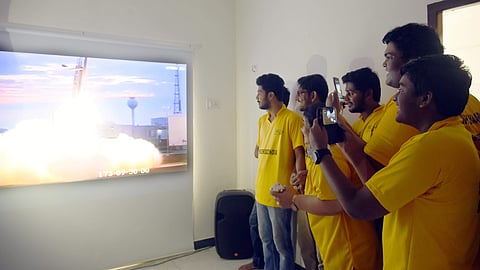

Remember that 18-year-old boy who created the world's lightest satellite? Well, it wasn't just him. A group of six other young student-scientists worked on the 64-gram-heavy satellite, named Kalam Sat, which was successfully launched on Thursday at NASA’s Wallops Space Center.
Called Space Kidz India, this group is trying to unlock the path to affordable space missions. The team consists of Lead Scientist Rifath Sharook, Technical Engineer Yagna Sai, Design Engineer Vinay Bharadwaj, Flight Engineer Tanishq Dwivedi, Biologist Gobinath and Testing Engineer Mohammed Kaasif. All seven of them are students
Kalam Sat is so tiny that this Carbon fiber made satellite fits inside a 4cm cube. Also, it is the world's first 3-D printed satellite. The team worked hard for three and a half months to turn it into a reality and have now applied for a Guinness Record, pending confirmation.
Post the launch, we caught up with Dr Shrimathy K, Director, Space Kidz India who was the support system for these seven youngsters. Extremely thrilled at the acheivement, she takes us back in time to how the idea came about. "The initial idea was a 1 kg satellite. But the launch would cost between $50,000- $80,000. We started looking for ways to turn our dream of entering the space mission into reality," she recalls.
Luck favoured them in the form of a competition called Cubes in Space by I Doodle Learning, which is sponsored by NASA and the Colorado Space Grant Consortium. The competition that required them to create a four-cm-wide cube transcended into a satellite. "We did a lot of research on putting 10 sensors in a four-cm-wide cube. Also we had to find the smallest board possible and also a small but efficient computer. Everything had to be shrunk," says Shrimathy.
The students who are given different roles in this mission were then asked to bring in different ideas. Hours of brainstorming and then there was a brainwave, "Why don't we convert it into a satellite?" one of them asked. And that's how Kalam Sat was born. The next challenge was to reduce its weight. The solution came in the form of 3D printing. "We had this discussion on a table while having Gulab Jamuns. Guess what! We ended up making something as small as one," jokes Shrimathy.
Now let's go back to the 18-year-old boy. He is Rifath Sharook, the mission's lead scientist. "I found Rifath at a competition that we organised to identify talented young scientists. He didn't win competitions initially, but I knew that he had a spark in him," says Shrimathy. She recalls how her and Rifath worked overnight on ideas. "He is a very talented child. His father was a scientist and he'd watch satellite launches ever since he was a little kid," she says.
